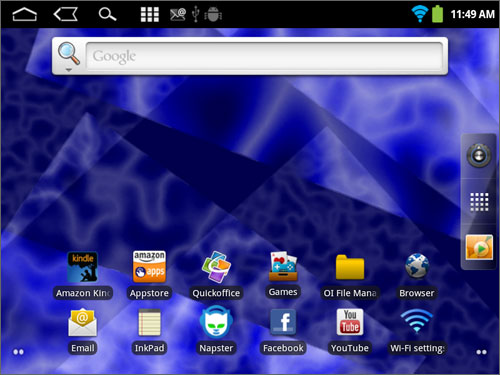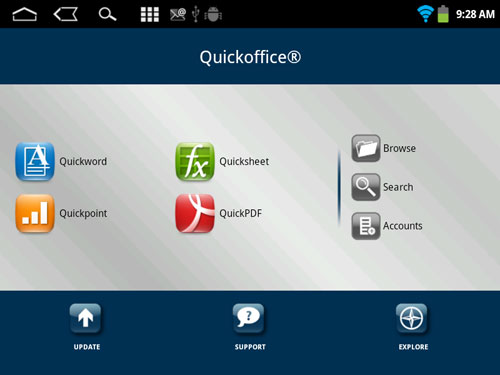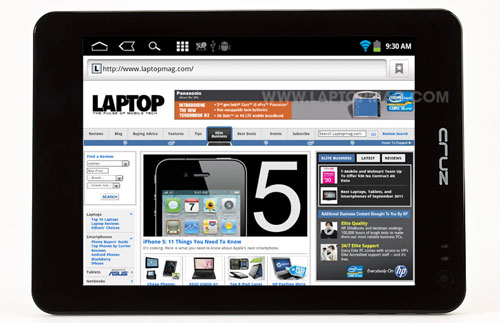Laptop Mag Verdict
The 8-inch Velocity Micro Cruz T408 Android tablet offers an attractive design for a budget-friendly price, but its performance and screen could be better.
Pros
- +
Affordable
- +
Attractive design
- +
Responsive capacitive touchscreen
- +
Long battery life
Cons
- -
Awkward Android interface tweaks
- -
Low-res display
- -
Somewhat sluggish performance
- -
Weak audio
Why you can trust Laptop Mag
The $239 Velocity Micro Cruz T408 tablet was designed with first-time tablet users and students in mind. Hoping to hit the consumer sweet spot of affordability and functionality, the Cruz T408 offers stylish looks, an 8-inch display, and decent speed. But is that enough to satisfy? Read on to find out.
Design
The Cruz T408 puts its best face forward with a plastic glossy black bezel surrounding an 8-inch matte capacitive display. The rounded edges give the tablet a soft elegant look that complements the soft-touch back. After 5 minutes of touching, we had to reach for a cloth to combat the smudge buildup. While the exterior of the T408 is comprised of plastic, the internal frame is made of aluminum for additional stability.
The top of the Velocity Micro tablet houses a microSD card slot, a microUSB port, and a headphone jack. A front-facing camera sits in the top right-hand corner of the slate across from the white Cruz insignia. The power and volume buttons--the T408's only physical buttons--reside on the right. Noticeably absent are a rear-facing camera and a HDMI port.
Click to enlarge
While the 1.1-pound Cruz T408 is a hair lighter than the 1.2-pound Vizio 8-inch tablet, its 8.5 x 6.5 x 0.4-inch frame is taller than the 8.1 x 6.6 x 0.5 Vizio slate. The Pandigital Nova is the most petite of the three, weighing 1 pound and measuring 7.6 x 5.3 x 0.5 inches, but it also has a smaller 7-inch screen.
Display and Audio
Sign up to receive The Snapshot, a free special dispatch from Laptop Mag, in your inbox.
Click to enlarge
Images on the 8-inch, 800 x 600-pixel matte display appeared dark, but details were relatively sharp with vibrant color. While the T408 had good horizontal viewing angles, vertical viewing angles were narrower, with images washing out at about 45 degrees. Still, watching the John Carter trailer on YouTube revealed a bright blue sky juxtaposed against a barren brown wasteland.
By comparison, the same trailer on the Pandigital Nova looked dull and listless, but both were trumped by the Vizio's display, which shone with its generous viewing angles and brighter colors. It's also worth noting that the Vizio tablet's screen has a higher resolution (1024 x 768), as does the upcoming Amazon Kindle Fire (1024 x 600).
While the video was passable, audio was not. The lone speaker on the tablet's rear failed to fill a small room and sounded tinny at maximum volume. The 8-inch Vizio tablet stereo speakers are more robust.
Software and Interface
Citing its inherent stability and better app support, Velocity Micro packaged the Cruz T408 with a customized Android 2.3 user interface instead of Honeycomb, which is weird since it's skinned to look like the latter. Honeycomb-reminiscent icons for Home, Back, Search, and Menu reside in the header across from indicators for Wi-Fi and Battery and a clock. As with all Gingerbread devices, the notifications shade is accessed by pulling down on the header.
Click to enlarge
The unlock screen features the standard sliding lock with a large clock located at the top and the sound off option on the left. The T408's home screen features the Google search bar located near the top, while icons for Applications, Image Gallery, and Settings line the bottom.
The five additional home screens feature Facebook and Twitter widgets, a calendar, a media screen with YouTube, Napster, and music player, and an alarm page with buttons to activate Wi-Fi, account syncing, and screen brightness.
| Click to enlarge | Click to enlarge |
Unfortunately, the lack of physical navigation buttons forced us to rely on the navigation icons in the header. Having to constantly reach for the top of the screen for the home and back buttons quickly became annoying, especially in portrait mode.
Keyboard
Click to enlarge
\The Cruz's spacious keyboard made typing a pleasurable experience. Although holding down select keys would display alternate characters, including numbers, we still had to use the alternative keyboard to access the @, %, and $ symbols. We were also disappointed that there was no haptic feedback support.
Apps
Instead of the Android Market, the T408's apps are provided by the Amazon Appstore and GetJar, which means no apps for Gmail, Google Talk, or Google Maps. The slate comes with a few useful and compelling apps, including Amazon Kindle, the full version of QuickOffice, Angry Birds Rio, and Napster.
Click to enlarge
Performance
The Velocity Micro Cruz T408 features a 1-GHz ARM Cortex A8 CPU with 512MB of RAM. On the Benchmark CPU test, the device scored a disappointing 1,411. That's 1,297 points below the category average for Android tablets. Still, the Vizio 8-inch tablet's 1-GHz processor only did slightly better, with 1,528 points.
Despite the lack of power, opening menus and launching most apps took just 1 to 2 seconds. Some apps, such as the Amazon Appstore, took 5 to 7 seconds to open.
The T408 fared better in the graphics department, scoring 7,454 on the AN3DBench test, which bested both the Vizio's score of 5,885 and the 7,037 category average.
Gestures on the Cruz were fairly quick and responsive. We were able to pinch-to-zoom text and images smoothly. However, there was a slight lag when scrolling down web pages, which resulted in a jarring jerkiness.
Web
Click to enlarge
Web surfing on the Cruz T408 didn't feel very fast. The slate took 17.5 seconds to load Laptopmag.com and 13.4 seconds to load the mobile version of ESPN.com. Loading the mobile version of The New York Times was significantly faster at 6.1 seconds, but it's more text based.
Camera and Video
Click to enlarge
Images captured by the 0.3-megapixel front-facing camera came out dark and relatively grainy. While the camera is capable of video chat, the T408 doesn't come pre-loaded with viable applications. After we installed Tango, our caller reported blocky images with a noticeable lag with clear audio. Images on our end had moderate pixelation, and the audio was loud and clear.
Battery Life
Velocity Cruz claims that the T408 can last more than 10 hours with general use and 6 hours if running video. After constant web surfing via Wi-Fi, watching video, playing Angry Birds Rio and Fruit Ninja, and social networking, we were able to squeeze approximately 8 hours and 45 minutes out of the slate. That kind of runtime will get you through most of the day. We will update this review with the results from the LAPTOP Battery Test.
Click to enlarge
Verdict
The $239 Velocity Cruz T408 tablet's affordable price will be very attractive to students and frugal tablet shoppers of all ages. And unlike with the Kindle Fire, you can use this slate to make video calls. However, the slate's somewhat sluggish performance and low-res display are turn-offs, as is the awkward skinning of Android. While the Cruz T408 is certainly worth a look, you'll probably be better off picking up the $199 Kindle Fire. Amazon's slate will have a faster dual-core CPU, a zippier browser, simpler interface, and easy access to more content.
Velocity Micro Cruz T408 Specs
| Brand | Velocity Micro |
| CPU | 1GHz ARM Cortex A8 CPU |
| Card Readers | microSD |
| Company Website | http://www.velocitymicro.com/ |
| Display Resolution | 800 x 600 |
| Display Size | 8 |
| Front-Facing Camera Resolution | 0.3 |
| OS | Android 2.3 |
| Ports | microUSB, Headphone |
| RAM Included | 512MB |
| Size | 8.5 x 6.5 x 0.4 -inches |
| Storage Drive Size | 4GB |
| Storage Drive Type | micro SD Card |
| Weight | 1.1 pounds |
| Wi-Fi | 802.11b/g/n |

Sherri L. Smith has been cranking out product reviews for Laptopmag.com since 2011. In that time, she's reviewed more than her share of laptops, tablets, smartphones and everything in between. The resident gamer and audio junkie, Sherri was previously a managing editor for Black Web 2.0 and contributed to BET.Com and Popgadget.







